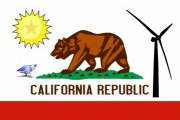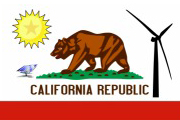
This is basically the actual new flag of the state.
Somewhat buried in the election-night hoopla was California Proposition 39. (No, not the GMO one. That was Prop 37.) Prop 39 was hailed as the “Clean Energy Jobs Act,” suggesting that the state close a corporate tax loophole that would bring an additional $1 billion in revenue to the state. Half of that, then, would go to green buildings.
From the Los Angeles Times:
Bay Area investor Tom Steyer placed the measure on the ballot to raise $1 billion annually for the state, with the money to be split between the general fund and a new $500-million program to promote green buildings.
Steyer spent more than $28 million on the effort, paying for almost the entire campaign himself.
Steyer is also the donor who in 2009 gave $40 million to Stanford University to create an institute to study renewable energy.
With nearly all of the vote in, Prop 39 passed by a wide margin.
So what’s next? The state will create the “Clean Energy Job Creation Fund.” As described in the proposition’s ballot language, money from the fund will be used to “create jobs in California improving energy efficiency and expanding clean energy generation” by focusing on retrofits to schools and other public buildings. Additional funds will go to job training programs and Property Assessed Clean Energy programs in public-private partnerships.
California’s direct-democracy proposition format is an often clunky, always piecemeal way of addressing problems. But in this case, at least, the system worked effectively: curbing a widely criticized loophole for the benefit of the state and dedicated investment in the sorts of green improvements that will continue to pay off for the state over the long run.
This post is part of our November 2012 theme: Post-election hangover — whither the climate?




